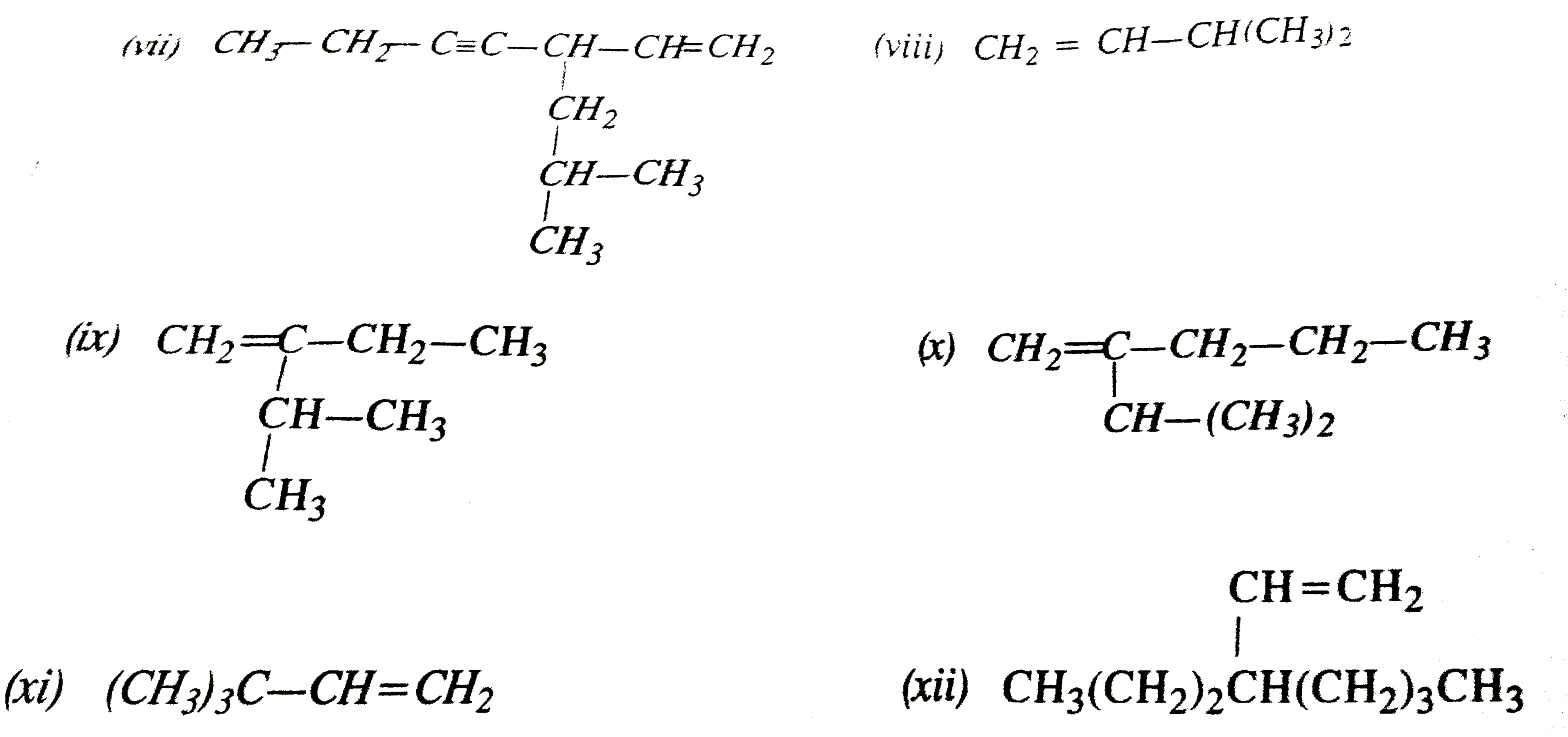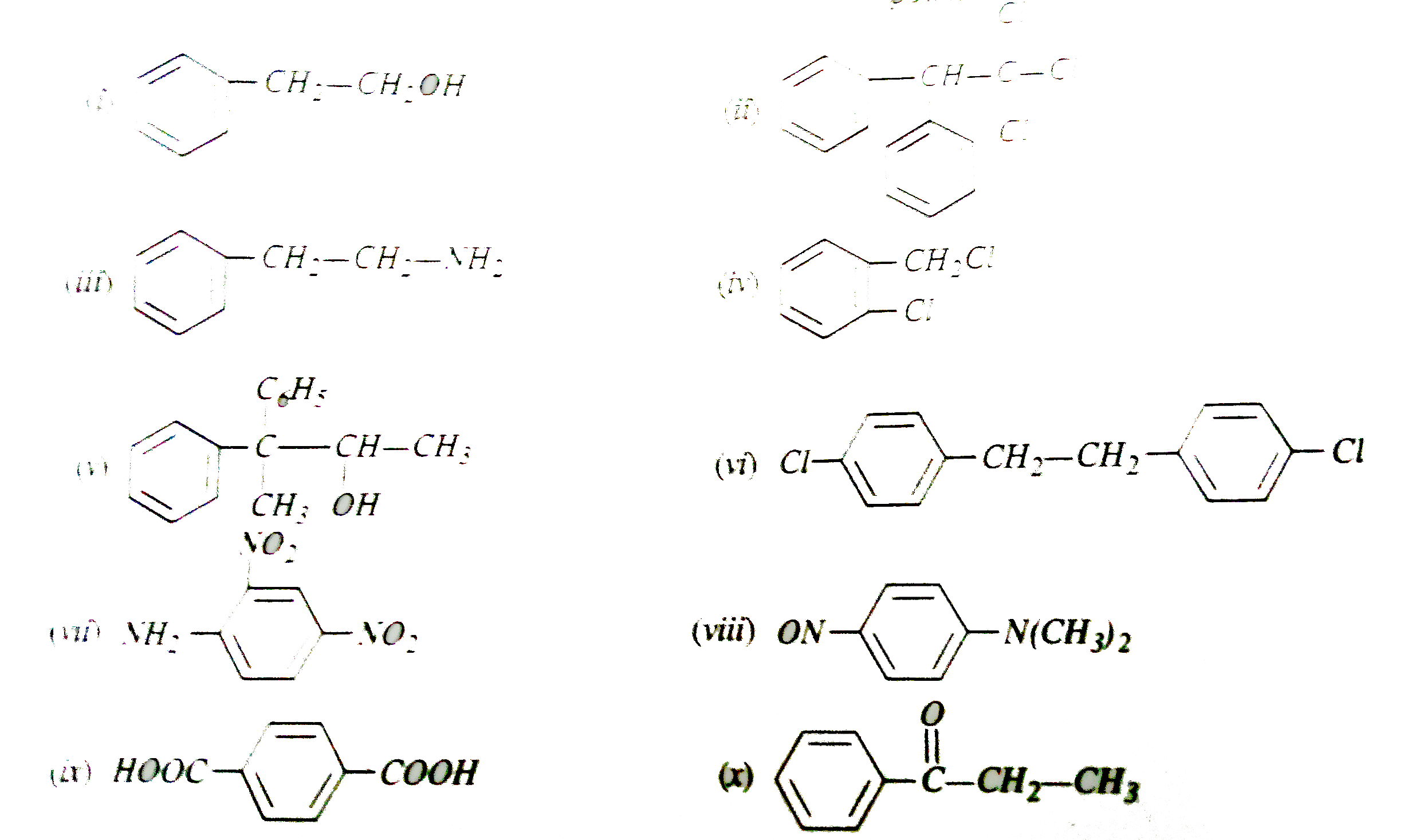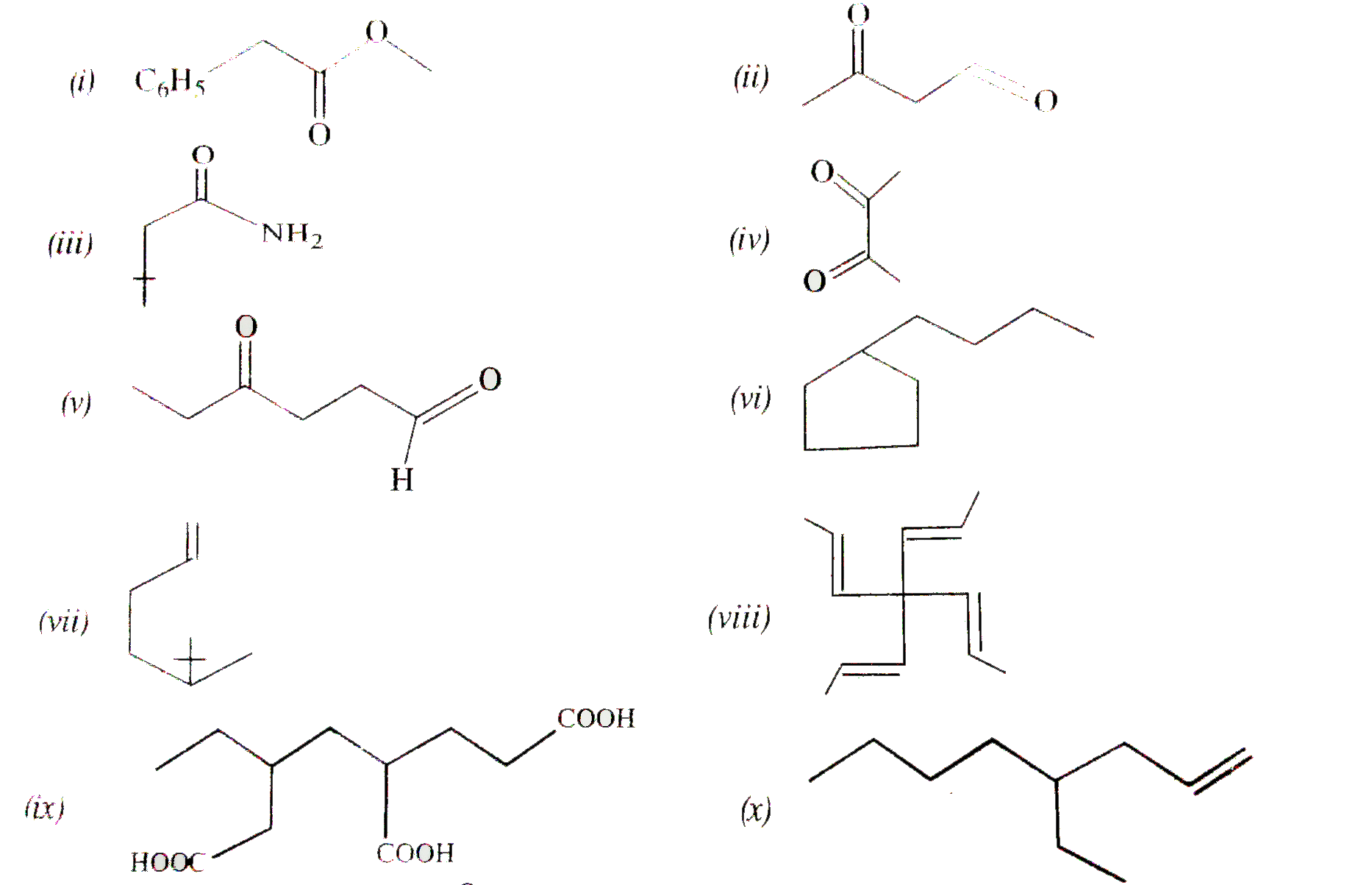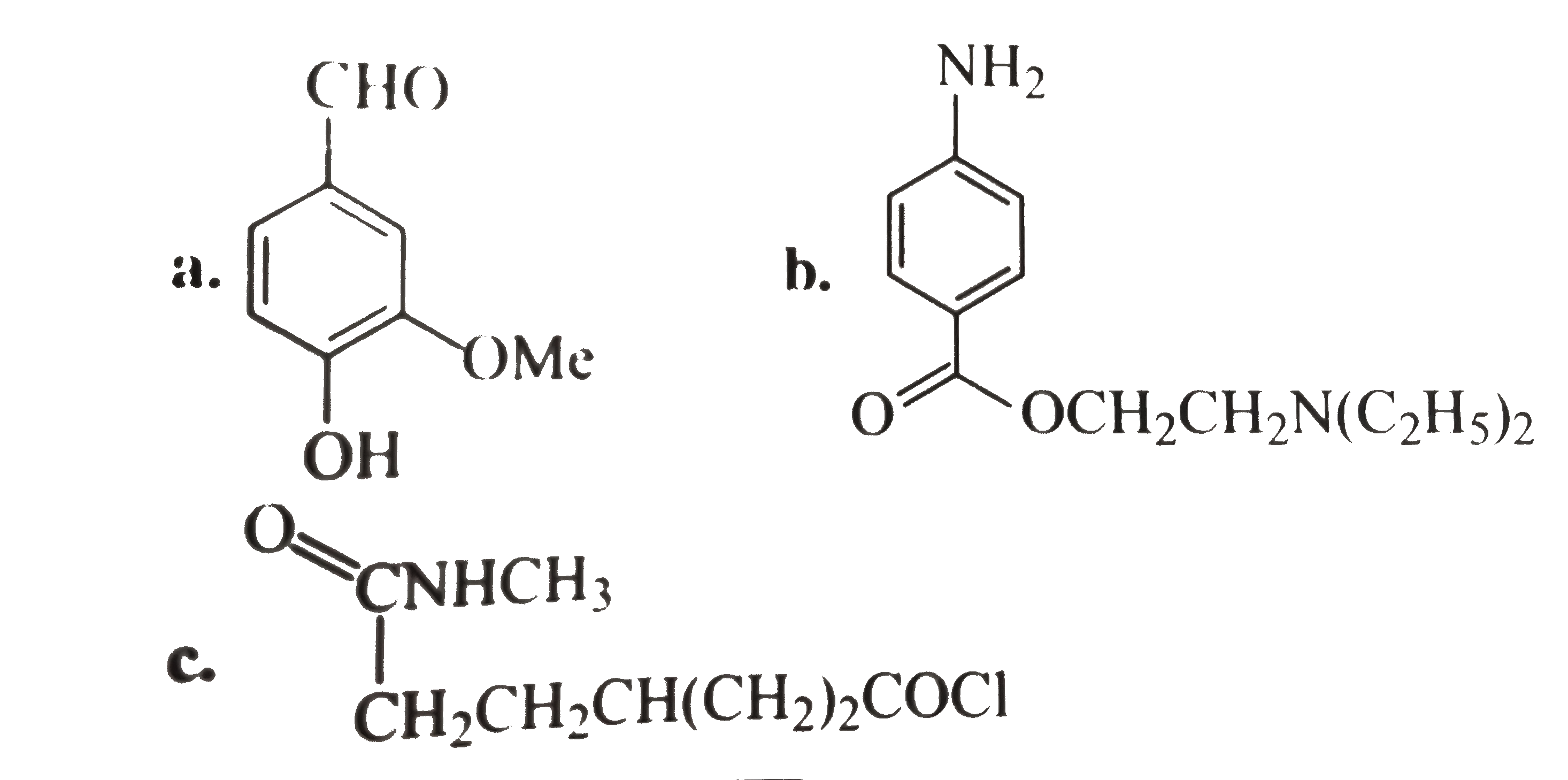SHORT ANSWER TYPE QUESTION from S DINESH & CO CHEMISTRY (HINGLISH) ORGANIC CHEMISTRY - SOME BASIC PRINCIPLES & TECHNIOUES for Class 11
| Class 11 | CHEMISTRY |
| Chapter | ORGANIC CHEMISTRY - SOME BASIC PRINCIPLES & TECHNIOUES |
| S DINESH & CO CHEMISTRY (HINGLISH) | SHORT ANSWER TYPE QUESTION |
| Medium | English |
| Academic Year | 2023-2024 |
Question 7
Draw the structures of the following compounds.
(i) Hex-3-enoic acid, (ii) 2-chloro-2-methylbutan-1-ol
(iii) 5, 5-Diethylnonan-3-ol, (iv) Propane-1, 3-diamine
(v) 4-Nitropent-1-yne, (vi) But-2-ene-1, 4-dioic acid
(vii) 4-Amino-2-ethylpent-2-enal, (viii) Ethyl-3-methoxy-4-nitrobutanoate
(ix) 5-(1-Methylethyl)-3-methyloctane, (x) Hex-4-yn-2-one
(xi) Hepta-1, 4 -dien-3-ol, (xii) 4-Chloropent-2-ene
(xiii) 1-Phenylpropan-2-one, (xiv) 4-Ethyl-2, 6-dimethyldec-4-ene.View SolutionQuestion 15
(a) Which of the following are position isomers ?
(i) CH2=CH (ii) CH3−C−CH3 (iii) CH3−CH=C−CH3 | || | CH2−CH3 CH2 CH2
(b) Write the IUPAC name of the functional isomer of CH3CH2CH2CH2CHO.
(c) Which type of structural isomerism is shown by the following pair of compounds ?
Br CH3 | |CH3−CH−CHBr2andBr2CH−CH−BrView SolutionQuestion 24
An organic compound on analysis gave the following data:
(i). 0.25 gm of the compound on complete combustion gave 0.37 gm of CO2 and 0.2 gm of water.
(ii). 0.25 gm of the compound on analysis by Dumas method gave 32 ml of nitrogen gas at STP.
Calculate the percentages of C,H,N and Oin the organic compounds.View SolutionQuestion 26
In Kjeldahl's method, 0.4422 g of an organic compound was digested with conc. H2SO4. The ammonia evolved on distilling the resulting solution with excess of NaOH solution was absorbed in 50 mL of 1 N H2SO4 solution. The residual acid required 65.5 mL of N/2 alkali solution for complete neutralisation. Find the percentage of nitrogen in the given organic compound.View SolutionQuestion 27
1.216 g of an organic compound was Kjeldahlised and the ammonia evolved was absorbed in 100 mL of 1-N H2SO4. The remaining acid solution was made upto 500 mL by dilution with water. 20 mL of this diluted solution required 32 mL of N/10NaOH solution for complete neutralisation. calculate the percentage of nitrogen in the compound.View SolutionQuestion 92
Three students, Manish, Ramesh and Rajini were determining the extra elements present in an organic compound given by their teacher. They prepared the Lassaigne's extract (L.E.) independently by the fusion of the compound with sodium metal. Then they added solide FeSO4 and dilute sulphuric acid to a part of Lassaigne's extract. Manish and Rajni obtained prussian blue colour but Ramesh got red colour.
Ramesh repeated the test with the same Lassaigne's extract, but again got red colour only. They were surprised and went to their teacher and told him about their observation. Teacher asked them to think over the reason for this. Can you help them by giving the reason for this observation. Also, write the chemical equations to explain the formation of compounds of different colour.View SolutionQuestion 106
You have the mixture of three liquids (A), (B) and (C). There is a large difference in the boiling points of (A) and rest of the two liquids i.e. (B) and (C). Boiling point of liquids (B) and (C) are quite close. Liquid [A] boils at a higher temperature than [B] and [C] and boiling point of (B) is lower than that of (C). How will you separate the components of the mixture. draw a diagram showing set up of the apparatus for the process.View SolutionQuestion 107
Draw a diagram of bubble plate type fractionating column. When do we require such type of a column for separating two liquids. Explain the principle involved in the separation of components of a mixture of liquids by using fractionating column. What industrial applications does this process have ?View SolutionQuestion 117
What happends when :
(a) Aqueous solution of lead acetate and sodium sulphide are mixed with each,
(b) A few drops of sodium nitroprusside are added to the aqueous solution containing sodium suphide.
(c) An aqueous solution containing sodium iodide is treated with a few drops of CS2 followed by excess of chlorine water.
(d) Phoshorus is fused with sodium peroxideView SolutionQuestion 125
Which of the following statemets are false ? Assign suitable explanation wherever possible.
(a) Beilstein test is a reliable test for halogens in organic compounds.
(b) The presence of nitrogen in Lassaigne's test can be shown with the help of Prussian blue colour.
(c) Lassaigne's test for the detection of sulphur fails if the compound is of volatile nature.
(d) If the compound contains both N and S, then a brick red colour is obtained in the Lassaigne's test.
(e) Methods are available to detect oxygen in a compound.
(f) Naphthalene can be separated from ammonium chloride by sublimation method.
(g) The coloured impurities present in an organic compound can be removed with the help of animal charocal.
(h) A mixture of o−nitrophenol and p−nitrophenol can be separated by steam distillation
(i) Chromatographic methods can be used to purify impure compounds available in any amount.
(j) The purpose of boiling Lassaigne's extract with conc. HNO3 before testing for halogens is to destroy any Na2S or NaCN if formed in the reactionView SolutionQuestion 126
Suggest a method to separate the constituents from the following mixture :
(i) Mixture of two miscible liquids.
(ii) A mixture of oil and water.
(iii) A mixture of plant pigments.
(iv) A mixture of ether and water.
(v) A mixture of solid nemzoic acid and sodium chloride.
(vi) o-nitrophenol and p-nitrophenol present in a mixture.View SolutionQuestion 128
Point out the false statements from the following and rectify them :
(a) The members in a homologous series can be represented by same general formula.
(b) CnH2n is the general formula for the members of alkane familt.
(c) Prefixes n-, iso-, tert-, neo- etc. are used in the IUPAC names of the compounds.
(d) Neohyfrocarbon contains a tertiary carbon atom.
(e) Propane consists of two primary and one secondary carbon atoms.
(f) Chemical properties of compounds are those of the functional groups.
(g) CHO group gets priority over COOH group in writing the IUPAC names of the compounds.View SolutionQuestion 153
Compounds having the same molecular formula but different structures are classified as structural isomers. Structural isomerism include chain, position, functional, group isomerism and metamerism.
answer the following questions on the basis of above paragraph :
(i) What is functional isomerism ?
(ii) CH3OC3H7 and C2H5OC2H5 represent which type of isomers ?View SolutionQuestion 154
Chromatography is a recent and most effective technique which was used by Tsweff, a botanist for the separation of coloured substances into individual constutients. The name Chromatography means colour writing (In Greek , Chrome = colour, graphy = writing). However, the name as such has lost its significance. The technique can be used to separate constituents from any mixture whether coloured or colourless.
(i) What is the basic of Chromatographic separation ?
(ii) What is the value associated with it ?View SolutionQuestion 155
A student was asked by his teacher to separate an impure sample of sulphur containing sand as the impurity. He tried to purify it with the help of sublimation. But he was not successful. Particles of sulphur of sulphur could not be separated completely from sand.
(i) Why did the sublimation process succeed ?
(ii) Suggest an alternate method to affect the separation.
(iii) What is the value based information associated with this ?View SolutionQuestion 156
Amit was asked by his teacher to separate a liquid mixture of acetone and ethyl alcohol. He set up a distillation apparatus and tried to distil the mixture. To his surprise, both the liquids got distilled. Teacher told Amit to repeat the experiment by using a fractionating column in the distillation flask. Amit followed the advice of the teacher and was able to separate the two liquids.
(i) Why was Amit not successful in separating the liquid mixture earlier ?
(ii) Why did teacher ask him to use the fractionating column ?
(iii) Which liquid was distilled first ?
(iv) As a student of chemistry, what value based information you have gathered ?View Solution
All Exercises from S DINESH & CO CHEMISTRY (HINGLISH) Class 11 CHEMISTRY ORGANIC CHEMISTRY - SOME BASIC PRINCIPLES & TECHNIOUES
- ASSERTION-REASON
- ASSIGNMENT
- DETECTION & ESTIMATION OF ORGANIC COMPOUNDS
- MATCHING TYPE
- MATRIX
- MCQB
- MCQS
- NCERT EXEMPLAR PROBLEMS
- PROBLEMS FOR PRACTICE
- PURIFICATION & CHARACTERISATION OF ORGANIC COMPOUNDS
- PURIFICATION OF ORGANIC COMPOUNDS
- SOME BASIC PRINCIPLES IN ORGANIC CHEMISTRY
- ASSERTION-REASON
- ASSIGNMENT
- DETECTION & ESTIMATION OF ORGANIC COMPOUNDS
- MATCHING TYPE
- MATRIX
- MCQB
- MCQS
- NCERT EXEMPLAR PROBLEMS
- PROBLEMS FOR PRACTICE
- PURIFICATION & CHARACTERISATION OF ORGANIC COMPOUNDS
- PURIFICATION OF ORGANIC COMPOUNDS
- SOME BASIC PRINCIPLES IN ORGANIC CHEMISTRY
- ASSERTION-REASON
- ASSIGNMENT
- DETECTION & ESTIMATION OF ORGANIC COMPOUNDS
- MATCHING TYPE
- MATRIX
- MCQB
- MCQS
- NCERT EXEMPLAR PROBLEMS
- PROBLEMS FOR PRACTICE
- PURIFICATION & CHARACTERISATION OF ORGANIC COMPOUNDS
- PURIFICATION OF ORGANIC COMPOUNDS
- SOME BASIC PRINCIPLES IN ORGANIC CHEMISTRY
- ASSERTION-REASON
- ASSIGNMENT
- DETECTION & ESTIMATION OF ORGANIC COMPOUNDS
- MATCHING TYPE
- MATRIX
- MCQB
- MCQS
- NCERT EXEMPLAR PROBLEMS
- PROBLEMS FOR PRACTICE
- PURIFICATION & CHARACTERISATION OF ORGANIC COMPOUNDS
- PURIFICATION OF ORGANIC COMPOUNDS
- SOME BASIC PRINCIPLES IN ORGANIC CHEMISTRY
- CONCEPT BASED QUESTION
- EXAMPLE
- N.C.E.R.T.
- SHORT ANSWER TYPE QUESTION
- VALUE BASED QUESTION
- CONCEPT BASED QUESTION
- EXAMPLE
- N.C.E.R.T.
- SHORT ANSWER TYPE QUESTION
- VALUE BASED QUESTION
- CONCEPT BASED QUESTION
- EXAMPLE
- N.C.E.R.T.
- SHORT ANSWER TYPE QUESTION
- VALUE BASED QUESTION
- CONCEPT BASED QUESTION
- EXAMPLE
- N.C.E.R.T.
- SHORT ANSWER TYPE QUESTION
- VALUE BASED QUESTION























